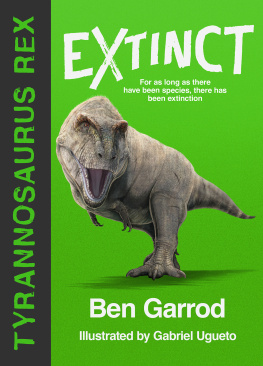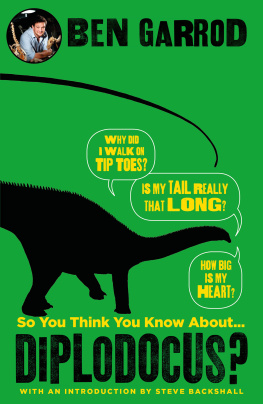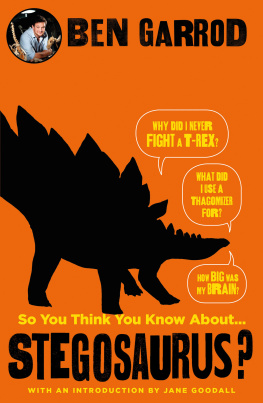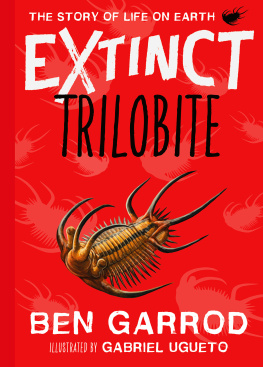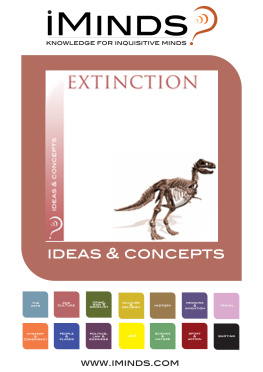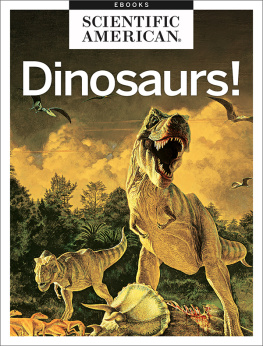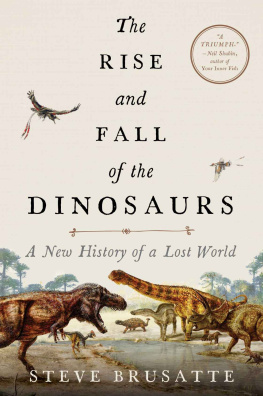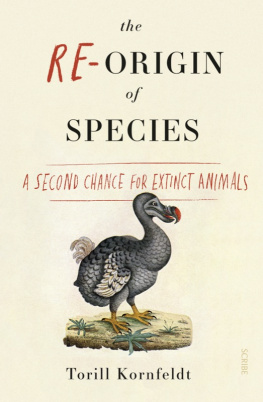
Hallucigenia
Dunkleosteus
Trilobite
Lisowicia
Tyrannosaurus rex
Megalodon (March 2022)
Thylacine (March 2022)
Hainan gibbon (May 2022)
ALSO BY BEN GARROD
The Chimpanzee and Me
So You Think You Know About Dinosaurs? series:
Diplodocus
Triceratops
Spinosaurus
Tyrannosaurus rex
Stegosaurus
Velociraptor

Ben Garrod
Illustrated by Gabriel Ugueto
AN IMPRINT OF HEAD OF ZEUS
www.headofzeus.com
This is a Zephyr book, first published in the UK in 2021 by Head of Zeus Ltd
Text copyright Ben Garrod, 2021
Artwork copyright Gabriel Ugueto, 2021
The moral right of Ben Garrod to be identified as the author and of Gabriel Ugueto to be identified as the artist of this work has been asserted in accordance with the Copyright, Designs and Patents Act of 1988.
All rights reserved. No part of this publication may be reproduced, stored in a retrieval system, or transmitted in any form or by any means, electronic, mechanical, photocopying, recording, or otherwise, without the prior permission of both the copyright owner and the above publisher of this book.
A catalogue record for this book is available from the British Library.
ISBN (HB): 9781838935382
ISBN (E): 9781838935405
Head of Zeus Ltd
58 Hardwick Street
London EC1R 4RG
WWW.HEADOFZEUS.COM
There is no reason to suppose that our stay here will be any more permanent than that of the dinosaurs.
David Attenborough
CONTENTS
For as long as there has been life on Earth, there has been extinction, and given enough time, all species will one day go extinct. Every day, it seems, we hear more and more tragic stories about more and more species being closer to extinction. There are scientists, conservationists, charities, universities, communities and even a few good governments fighting against extinction and trying to save some of our most treasured species and habitats. But, and there is a but to this story, extinction has its place in our world and, at the right level and at the right time, it is a perfectly natural occurrence and can even help evolution in some ways.
I am a scientist. Its the very best job in the world. In my work, I look at evolution and Ive been lucky enough to spend time with some of the most endangered species on our planet, as well as a few which have already gone extinct. Im fascinated by the effects extinction has on nature, in the broader sense. But how much do we really know about extinction?
If we are to ever stand a chance of saving species from extinction, then first we need to understand it. What is extinction? What causes it? What happens when many species go extinct at once? I want to explore extinction as a biological process and investigate why it can sometimes be a positive thing for evolution, as well as, at times, natures most destructive force. Lets put it under the microscope and find out everything there is to know.
When a species goes extinct, we place a dagger symbol () next to its name when its listed or mentioned in a scientific manner. So, if you do see the name of a species with a little dagger after it, youll know why. Its extinct. In this series, I have written about eight fantastic species. Starting with Hallucigenia (), then Dunkleosteus () and trilobites (), through to Lisowicia (), Tyrannosaurus rex () and megalodon (), before finishing with thylacine () and lastly, the Hainan gibbon. Of these, only the Hainan gibbon does not have a dagger next to its scientific name, meaning it is the only animal we still have a chance of saving from extinction.

Professor Ben Garrod

OFTEN IN BIOLOGY, as is the case with much of science, there are many definitions for a lot of complicated terms. Understanding the essence of extinction, though, is not especially complicated it is when the species is dead. Not just the individual animal or a large group of animals which are the same, but all animals of that species. When there are no more left alive and the last one dies, then that species is extinct. Lost. Gone forever.
Something I have a lot of trouble with when we talk about extinction is the question, So what? Who really cares if a species dies out? What difference does it really make? So what if another type of frog disappears? The truth is there are people who youll never convince that its vitally important we fight against extinction right now. Theyre frequently the same people who dont believe our climate is rapidly changing, and who argue against so much of modern science. But why does it matter if a species disappears? Theres a simple answer and a much more complicated answer. The simple answer is that as humans, we occupy a unique position in the animal kingdom. We understand a great deal. We have the power and the ability to completely shape and control the world around us, and with that comes a duty to protect others within our community, whether theyre our human neighbours in our street or our animal neighbours in forests and reefs and in our gardens.

Eurasian lynx
The second answer is because the natural world is a wondrous interconnected ecosystem, in which there are many examples of species linking to one another. Nature is like a big spider web, connecting billions of organisms with invisible strands, just like a web. If one species is removed, it pulls on another part of that web. If enough species are made extinct, then the whole structure is destroyed.
This idea helps you understand how removing natural predators from an ecosystem could mean that your home gets flooded. There are very few natural predators in the UK nowadays. Wolves and lynx have all been killed, and we trapped, shot and stole eggs from so many birds of prey that their numbers crashed. This gave prey animals, such as rabbits and deer, a huge opportunity. Their populations rose and rose, to the point where they ate so much vegetation, they changed the landscape, turning habitats dotted with bushes and trees to almost bare environments.

Eurasian wolf
*
Now, when there is heavy rainfall, the water runs straight down hills rather than soaking into the roots and thicker soil layers created by habitats with lots of trees and bushes. Streams and then rivers flood, which ultimately floods towns, villages and homes along the way. In reality, flooding is a lot more complicated than this, but this little example does help show how removing organisms from an environment can have far-reaching impacts. With so many species of plants, animals, fungi and other life, who knows what catastrophic effect a species going extinct might have.

